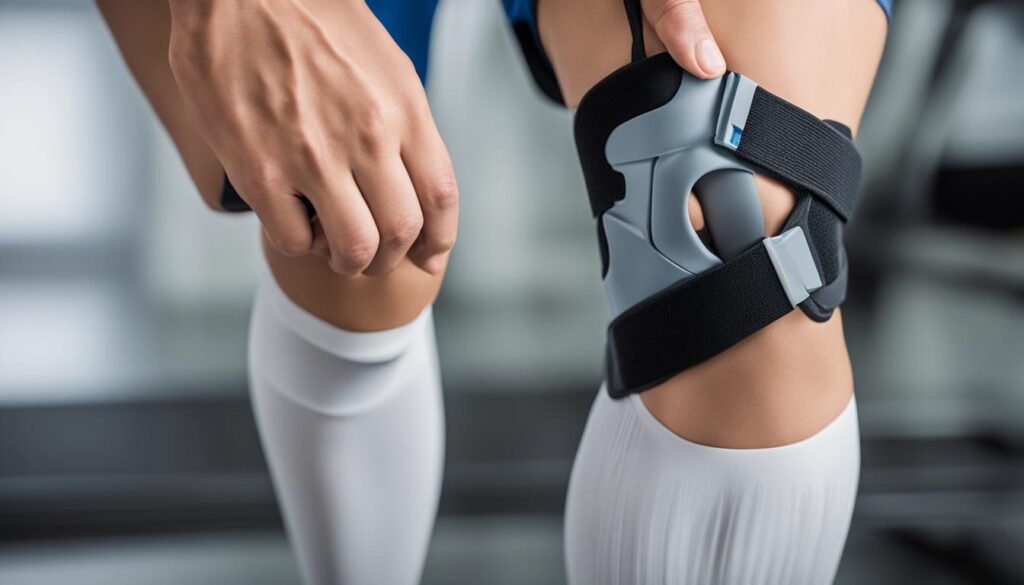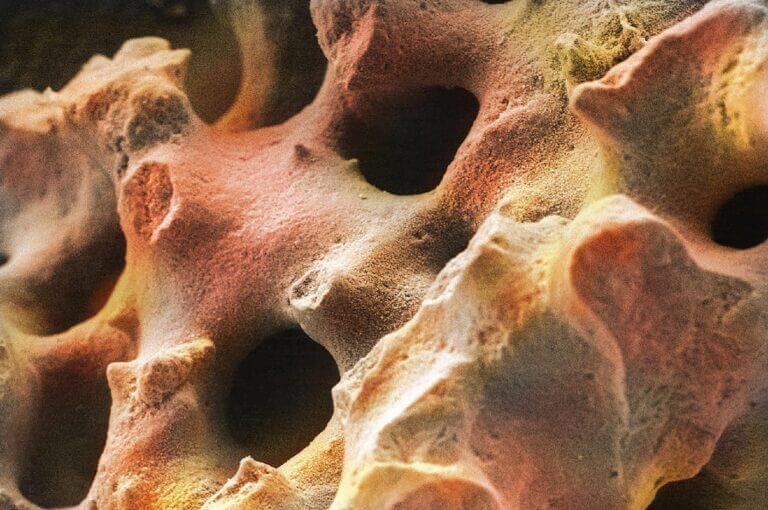Understanding Anterior Knee Pain & Relief Tips
Welcome to our comprehensive guide on understanding anterior knee pain, its causes, and effective relief tips. As a trusted source of information on knee health, treatment options, and exercises, we aim to provide you with valuable insights into managing this common issue.
If you’ve been experiencing discomfort in the front of your knee, you may be dealing with anterior knee pain. This condition can be caused by various factors, including patellofemoral pain syndrome, chondromalacia patellae, muscle imbalances, or overuse injuries. Activities like walking downstairs, squatting, and sitting for long periods can exacerbate the pain and even lead to feelings of instability.
Key Takeaways:
- Anterior knee pain can be caused by various conditions and factors.
- Proper diagnosis is crucial for effective management and relief.
- Activity modification and exercise therapy are key treatment options.
- Self-care measures, such as ice application and wearing appropriate footwear, can provide additional relief.
- Prevention and long-term management involve maintaining appropriate conditioning and activity modification.
Causes and Risk Factors of Anterior Knee Pain
When it comes to anterior knee pain, understanding the underlying causes and risk factors is crucial for effective management and prevention. The most significant risk factor for developing patellofemoral joint pain, a common cause of anterior knee pain, is weakness in the quadriceps muscles. The quadriceps, a group of muscles at the front of the thigh, play a vital role in stabilizing the patella and the knee joint. Weakness in these muscles can lead to imbalances, putting additional stress on the patellofemoral joint and causing pain and discomfort.
But quadriceps weakness is not the only factor that contributes to anterior knee pain. There are several other factors to consider:
- Muscle imbalances: Imbalances between the quadriceps and other muscles in the leg, such as the hamstrings, can disrupt the normal functioning of the knee joint and lead to anterior knee pain.
- Tight muscles: Tightness in the muscles surrounding the knee, including the quadriceps, hamstrings, and calves, can restrict joint movement and increase the risk of pain.
- Leg alignment issues: Problems with leg alignment, such as excessive inward or outward rotation of the femur or tibia, can place uneven pressure on the patellofemoral joint, causing discomfort.
- Improper sports training techniques or equipment: Incorrect form, inadequate warm-up, or using inappropriate equipment during physical activities can contribute to anterior knee pain.
- Changes in footwear or playing surface: Wearing shoes that do not provide proper support or participating in activities on hard, uneven surfaces can increase the risk of knee pain.
- Overdoing sports activities: Excessive or repetitive impact from high-intensity sports and activities can strain the knee structures and lead to anterior knee pain.
It’s important to note that lifestyle and activity levels also play a significant role in the development of anterior knee pain. Individuals who lead sedentary lifestyles or engage in activities that involve repetitive knee movements are more susceptible to this condition.
“Quadriceps weakness, muscle imbalances, leg alignment issues, improper training techniques, changes in footwear and playing surface, and overdoing sports activities can all contribute to anterior knee pain.”
By understanding these causes and risk factors, individuals experiencing anterior knee pain can take proactive measures to address the underlying issues and reduce their risk of further discomfort.
Treating Quadriceps Weakness: Exercise Therapy
One of the key factors contributing to anterior knee pain is weakness in the quadriceps muscles. To address this issue, exercise therapy focusing on quadriceps strengthening is often recommended. Here are a few exercises that can help improve quadriceps strength:
- Squats: Perform squats by slowly lowering your body as if you are sitting down, keeping the weight on your heels. Aim to maintain proper form and gradually increase the depth as your strength improves.
- Lunges: Step forward with one leg, bending both knees and lowering your body until the back knee is just above the ground. Push back up to the starting position and repeat with the opposite leg.
- Leg Press: Using a leg press machine or resistance band, push against the resistance using your legs, focusing on the quadriceps muscles. Start with lighter weights or resistance and gradually increase as you get stronger.
- Step-ups: Step onto a raised platform or step with one leg, pushing through the heel and engaging the quadriceps muscles. Step back down and repeat with the opposite leg.
It’s important to perform these exercises under the guidance of a qualified professional to ensure proper form and prevent any further injury.
Additionally, stretching exercises for the quadriceps and other leg muscles, as well as overall flexibility training, can help improve muscle balance and reduce the risk of anterior knee pain.
The Role of Lifestyle and Activity Levels
The lifestyle and activity levels of an individual can significantly contribute to the development of anterior knee pain. Sedentary individuals who lack regular physical activity may experience muscle weakness and imbalances, which can put additional stress on the knee joint. On the other hand, individuals who engage in excessive high-impact activities without proper conditioning and training are also at a higher risk.
Therefore, maintaining an active lifestyle that incorporates a balance of cardiovascular exercises, strength training, and flexibility exercises is crucial. Gradually increasing activity levels and avoiding sudden spikes in intensity can help minimize the risk of anterior knee pain.
The image above illustrates the location of the quadriceps muscles, highlighting their importance in knee stability and functioning.
| Causes of Anterior Knee Pain | Risk Factors |
|---|---|
| Quadriceps weakness | Sedentary lifestyle |
| Muscle imbalances | Excessive high-impact activities |
| Tight muscles | Improper training techniques |
| Leg alignment issues | Changes in footwear or playing surface |
Addressing the causes and risk factors of anterior knee pain is essential for effective management and prevention. By improving quadriceps strength, adopting proper training techniques, maintaining flexibility, and leading an active lifestyle, individuals can reduce their risk of experiencing anterior knee pain and promote overall knee health.
Symptoms and Diagnosis of Anterior Knee Pain
Anterior knee pain can be characterized by a variety of symptoms that cause discomfort and hinder daily activities. The most common symptom is a dull, achy pain in the front of the knee. This pain typically worsens with activities such as squatting, going up and down stairs, and engaging in high-impact exercises. It can also be accompanied by other sensations, including: knee discomfort, knee instability, patellar tenderness, and functional deficit.
“The pain that comes with anterior knee pain can make it difficult to perform tasks like going down the stairs or participating in physical activities,” says Dr. Sarah Johnson, a renowned orthopedic specialist. “Patients often describe the pain as a sharp ache or throbbing sensation in the front of their knee.”
In addition to pain, some individuals may experience popping or crackling sounds in the knee. They may also notice that the pain intensifies at night or when there are changes in their activity level or intensity. These symptoms can significantly impact an individual’s quality of life and hinder their ability to engage in physical activities.
Diagnosing Anterior Knee Pain
Proper diagnosis of anterior knee pain is essential to determine the underlying cause and develop an effective treatment plan. A comprehensive examination will involve assessing various factors related to the knee, including:
- Knee Stability: A physical examination will evaluate the stability of the knee joint, assessing for any instability or abnormal movement.
- Hip Rotation and Range of Motion: The range of motion and hip rotation will be assessed as tightness or limitations in these areas can contribute to anterior knee pain.
- Patellar Tenderness: The healthcare provider will check for tenderness or pain around the patella (kneecap), which can be an indication of patellofemoral pain syndrome.
- Muscle Strength: Assessing the strength of the muscles surrounding the knee, particularly the quadriceps, can help identify any muscle imbalances or weaknesses that may be contributing to the pain.
In some cases, imaging tests such as X-rays or magnetic resonance imaging (MRI) scans may be ordered to rule out other knee issues and provide a clearer picture of the internal structures of the knee.
By thoroughly evaluating the symptoms and conducting appropriate diagnostic tests, healthcare professionals can accurately diagnose anterior knee pain and develop a tailored treatment plan to address the individual’s specific needs.
Treatment Options for Anterior Knee Pain
When it comes to addressing anterior knee pain, a comprehensive treatment approach that combines activity modification and exercise therapy is highly effective. By making necessary adjustments to your activities and engaging in specific exercises, you can alleviate discomfort, improve knee function, and reduce pain.
Activity Modification
One of the key components of treating anterior knee pain is activity modification. This involves identifying and avoiding activities that exacerbate your symptoms. By reducing the stress on your knee joint and engaging in low-impact exercises, you can continue to stay active without aggravating the pain. Our team will provide guidance on appropriate modifications based on your individual needs and lifestyle.
Exercise Therapy
Exercise therapy plays a crucial role in strengthening the muscles that support your knee, especially the quadriceps and hip muscles. Through targeted exercises, we will help you improve muscle imbalances, increase stability, and enhance overall knee function. Our expert therapists will guide you through a customized exercise program designed to meet your specific goals and needs.
Physical Therapy
In some cases, physical therapy may be recommended to further support your recovery from anterior knee pain. This form of therapy focuses on improving strength, flexibility, and range of motion in your knee joint. Our skilled therapists will use a variety of techniques and modalities to optimize your rehabilitation process and promote healing.
Orthotics
For individuals with biomechanical issues or abnormalities contributing to anterior knee pain, orthotics may be recommended. These specialized shoe inserts can help correct foot and leg alignment, reduce excessive strain on the knee, and provide additional support. Our team will assess your needs and provide guidance on the appropriate orthotics for your condition.
By combining activity modification, exercise therapy, physical therapy, and the use of orthotics, we can effectively treat anterior knee pain and improve knee function. Our comprehensive approach aims to alleviate your pain, enhance your mobility, and allow you to get back to the activities you love with confidence.

Self-Care Tips for Anterior Knee Pain Relief
In addition to professional treatment, there are self-care tips that can help relieve anterior knee pain. By incorporating these practices into your daily routine, you can take an active role in managing your discomfort and promoting the healing process.
1. Activity Modification
Modify your activities to reduce excessive strain on the knee joint. Avoid high-impact exercises that may exacerbate the pain and opt for lower-impact alternatives. Gradually increase your physical activity level to avoid overloading the knee.
2. Targeted Exercises
Engage in specific exercises that target the quadriceps and hip muscles. Strengthening these muscles can help improve knee stability and alleviate anterior knee pain. Consult with a physical therapist or exercise specialist for guidance on exercises suitable for your condition.
3. Ice Application
Applying ice to the knee after physical activity can help reduce inflammation and alleviate discomfort. Use a cold pack or wrap ice in a towel and apply it to the affected area for 15-20 minutes at a time. Remember to always wrap the ice to protect your skin from direct contact.
4. Orthotics
Consider using orthotics, such as knee braces or shoe inserts, to provide additional support to the knee joint. Orthotics can help improve alignment and ease the pressure on the affected area. Consult with a healthcare professional to determine the most suitable orthotic option for your specific needs.
5. NSAIDs
Over-the-counter nonsteroidal anti-inflammatory drugs (NSAIDs), such as ibuprofen or naproxen, can be used to temporarily relieve pain and reduce inflammation. However, it is important to follow the recommended dosage and consult with a healthcare professional if you have any underlying medical conditions or concerns.
By following these self-care tips, you can enhance your overall well-being and support the healing process of anterior knee pain. However, it is essential to consult with a healthcare professional for a proper diagnosis and personalized treatment plan.
Remember, self-care measures should be done in conjunction with professional guidance to ensure the most effective and safe management of anterior knee pain.
Prevention and Long-Term Management of Anterior Knee Pain
To prevent recurring anterior knee pain, it is crucial to maintain appropriate conditioning of the knee muscles, especially the quadriceps and hamstrings. This can be achieved through regular exercise that includes muscle strengthening and stretching. Muscle strengthening exercises, such as leg presses and squats, help to improve the stability of the knee joint and reduce strain on the patellofemoral joint. Stretching exercises, such as hamstring stretches and calf stretches, help to improve flexibility and reduce muscle tightness, which can contribute to anterior knee pain.
Activity modification is an essential aspect of preventing anterior knee pain. By avoiding or modifying activities that place excessive stress on the knees, individuals can reduce their risk of developing this condition. This may include avoiding activities that involve repetitive knee movements or high-impact exercises, and instead opting for lower impact activities like swimming or cycling. In sports training routines, it is important to consider appropriate techniques, equipment, and surfaces to minimize the risk of knee injuries.
It is important to note that anterior knee pain can take time to resolve, and persistence with exercises and self-care measures is necessary for long-term management. Maintaining a consistent exercise routine and incorporating ongoing strength and flexibility exercises can help to prevent the recurrence of symptoms. Additionally, maintaining appropriate conditioning through regular physical activity and staying within a healthy weight range are important factors in managing anterior knee pain.
“By implementing strategies such as activity modification and exercise therapy, individuals can effectively manage and prevent anterior knee pain, allowing for improved knee health and overall quality of life.”
Sample Exercise Routine for Anterior Knee Pain Prevention and Management
Below is a sample exercise routine that can help prevent and manage anterior knee pain. Remember to consult with a healthcare professional or physical therapist before starting any new exercise program:
| Exercise | Description |
|---|---|
| 1. Quadriceps Strengthening | Perform exercises such as leg presses, squats, and step-ups to strengthen the quadriceps muscles. |
| 2. Hamstring Strengthening | Include exercises like hamstring curls and glute bridges to strengthen the hamstrings and improve overall leg stability. |
| 3. Hip Strengthening | Include exercises like hip abductions and lateral band walks to strengthen the hip muscles, which help support the knee joint. |
| 4. Stretching | Incorporate stretches for the quadriceps, hamstrings, calves, and hip muscles to improve flexibility and reduce muscle tightness. |
| 5. Low-Impact Cardiovascular Exercise | Engage in activities like swimming, cycling, or using an elliptical machine to increase cardiovascular fitness without placing excessive stress on the knees. |
Remember to start with a warm-up before performing these exercises and to cool down afterwards. Be mindful of any pain or discomfort during the exercises, and adjust the intensity or range of motion as needed. Gradually increase the duration and intensity of the exercises over time to continue challenging the muscles and promoting improvement.

Conclusion
Anterior knee pain is a common condition that can have a significant impact on daily activities and athletic performance. To effectively manage this condition and improve knee health, it is essential to understand the underlying causes, identify the symptoms, and seek proper diagnosis.
We have learned that activity modification plays a crucial role in the treatment of anterior knee pain. By avoiding or reducing activities that cause discomfort and engaging in lower impact exercises, individuals can alleviate pain and prevent further damage to the knee. Exercise therapy, with a focus on strengthening the quadriceps and hip muscles, is also key in improving knee function and reducing pain.
Additionally, self-care measures such as applying ice to the knee after physical activity, using orthotics for added support, and incorporating specific exercises targeting the quadriceps and hip muscles can provide relief. Over-the-counter medications like NSAIDs may be used to temporarily manage pain and inflammation.
In conclusion, with the right approach that combines activity modification, exercise therapy, and self-care measures, individuals experiencing anterior knee pain can find relief and regain their quality of life. It is important to consult with a healthcare professional for proper guidance and long-term management of anterior knee pain.
FAQ
What can cause anterior knee pain?
Anterior knee pain can be caused by various conditions such as patellofemoral pain syndrome, chondromalacia patellae, and Osgood-Schlatter’s disease. It can also result from overuse injuries, muscle imbalances, or patella abnormalities.
What are the risk factors for developing anterior knee pain?
The biggest risk factor for developing anterior knee pain is weakness in the quadriceps muscles. Other factors that may contribute include muscle imbalances, tight muscles, leg alignment problems, improper sports training techniques or equipment, changes in footwear or playing surface, and overdoing sports activities. Lifestyle and activity levels are also important considerations.
What are the symptoms of anterior knee pain?
Symptoms of anterior knee pain typically include a dull, achy pain in the front of the knee that worsens with activities like squatting, going up and down stairs, and high-impact exercises. Other symptoms may include popping or crackling sounds in the knee, pain at night, and pain related to changes in activity level or intensity.
How is anterior knee pain diagnosed?
Diagnosing anterior knee pain requires a thorough examination, including assessing knee stability, hip rotation, and range of motion, as well as checking for patellar tenderness and muscle strength. Imaging tests such as X-rays or MRI scans may also be used to rule out other knee issues.
What are the treatment options for anterior knee pain?
The most effective treatment for anterior knee pain is a combination of activity modification and exercise therapy. This involves avoiding or reducing activities that cause discomfort while engaging in comfortable, lower impact exercises. Physical therapy and the use of orthotics may also be beneficial. In some cases, surgery may be necessary.
Are there any self-care tips for relieving anterior knee pain?
Yes, self-care tips can help relieve anterior knee pain. These include modifying activities to reduce overloading of the knee, specific exercises that target the quadriceps and hip muscles, applying ice to the knee after physical activity, wearing appropriate footwear, using orthotics, and using over-the-counter medications like NSAIDs to temporarily relieve pain and inflammation.
How can anterior knee pain be prevented and managed in the long term?
To prevent anterior knee pain from recurring, it is important to maintain appropriate conditioning of the knee muscles, especially the quadriceps and hamstrings. This can be achieved through regular exercise, including muscle strengthening and stretching. Activity modification is key to avoiding overloading the knee. It is important to remember that these problems take time to resolve, and persistence with exercises and self-care measures is necessary for long-term management.







